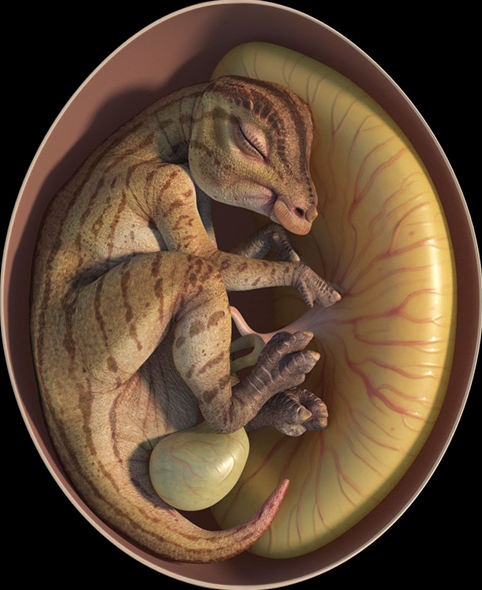A wide variety of Dinosaur eggs are now known from sites around the world, although eggs with embryos within remain relatively rare. For example, the Hadrosauroids, a large and diverse group of Dinosaurs, have embryonic forms assigned to only three species, Hypacrosaurus stebingeri, Maiasaura peeblesorum, and Saurolophus angustirostris. As a consequence of this, the earliest stages of Dinosaur development are nor well understood, and any new material of great interest to Dinosaur palaeontologists.
In a paper published in the journal BMC Ecology and Evolution on 9 May 2022, Lida Xing of the State Key Laboratory of Biogeology and Environmental Geology, and School of the Earth Sciences and Resources at the China University of Geosciences, and the Yingliang Stone Natural History Museum, Kecheng Niu, also of the Yingliang Stone Natural History Museum, Tzu‑Ruei Yang of the Institute of Vertebrate Paleontology and Paleoanthropology of the Chinese Academy of Sciences, and the Taiwan National Museum of Natural Science, Donghao Wang, also of the School of the Earth Sciences and Resources at the China University of Geosciences, Tetsuto Miyashita of the Beaty Centre for Species Discovery and Palaeobiology Section at the Canadian Museum of Nature, and Jordan Mallon, also of the Beaty Centre for Species Discovery and Palaeobiology Section at the Canadian Museum of Nature, and of the Department of Earth Sciences at Carleton University, describe two Hadrosauroid embryos from the Late Cretaceous Hekou Formation red beds of the Ganzhou Basin in Jiangxi Province, China.
Hadrosaurs have traditionally been divided into two groups, the Hadrosaurines, with solid crests, and the Lambeosaurines, with hollow crests. However, a revision of the taxonomy of the group in 2010 suggested that the species Hadrosaurus foulkii, from which the group takes its name, in fact lies outside the Hadrosaurinae, forming a sister group to the (Hadrosaurinae + Lambeosaurinae). If this is the case, then it is inappropriate for the Hadrosaurinae to be named after a species which falls outside the group, which has led to it being renamed the Saurolophinae. Since 2010 there have been several further attempts at resolving the phylogeny of the Hadrosauridae, some of which have recovered Hadrosaurus foulkii as falling outside the Hadrosaurinae (or Saurolophinae), while others have returned it to this group. In the absence of any clarity on this issue at this time, Xing et al. favour the term Hadrosaurine to describe Hadrosaurs with solid crests, without placing any phylogenetic implications on this usage.
Both embryos described came from a clutch which is recorded as having comprised 13 eggs at the time of discovery (the actual number may have been larger). The eggs themselves are not well preserved, but appear to have originally had a prolate spheroid shape (i.e a slightly lemon-shaped sphere), consistent with eggs of the oofamily Spheroolithidae, which is otherwise known from the Hekou Formation. However Xing et al. do not attempt to assign the eggs to a more specific taxon, as their shells are too poorly preserved to allow examination of their microstructure.
The first egg examined, (YLSNHM 01328) contains a partial articulated skeleton comprising the posterior part of the cranium, the complete series of cervical vertebrae, plus the forward part of the dorsal vertebral column and the associated ribs. Unfortunately the missing part of the skull includes the site where the palatal process of the maxilla, if present, would be found. This is unfortunate, as this is a reliable taxonomic trait within the Hadrosauridae, being present in the Hadrosaurinae and absent in the Lambeosaurinae.
The squamosal of YLSNHM 01328 is most similar to that of Tanius sinensis, Levnesovia transoxiana, and Nanningosaurus dashiensis (Nanningosaurus dashiensis is considered a Lambeosaurine, while the other two are known only from partial remains and cannot be assigned with confidence to the Hadrosaurinae or Lambeosaurinae), although the postorbital process of this bone is longer than in most Hadrosaurs of any type.
The second specimen, YLSNHM 01373 comprises a partial skeleton lacking parts of the skull, the tail, and the ends of the limbs. This specimen has a well preserved parietal bone, which can be seen to be elongate, as in Hadrosaurine, but not Lambeosaurine, Hadrosaurs. The specimen also has a well preserved tooth row, which has become detached from the its original position, although it is unclear whether that was on the upper or lower jaw. Assuming the first rib is attached to the first dorsal vertebra, YLSNHM 01373 has eleven cervical vertebrae, but it is unclear whether the first two visible cervical vertebrae are the atlas and axis (first two vertebrae) or whether these are hidden, so this number might be higher.
Both sets of embryonic remains can be confidently assigned to the Hadrosauridae, but lack sufficient diagnostic features to assign them to either the Hadrosaurinae or the Lambeosaurinae. One feature not dependent on morphology which has been suggested for differentiating these groups is size; it has been observed that, in Montana at least, Hadrosaurine eggs and embryos tend to be smaller than those of Lambeosaurs. Based upon femur lengths, the Hekou Formation embryos are closer to the Montana Hadrosaurines than the Montana Lambeosaurines (in fact they are slightly smaller). However, the Hekou Formation embryos do not fill their eggs, making it highly likely that they were some way short of hatching when they died, so this cannot realistically be used as a diagnostic feature in this case.
See also...
Online courses in Palaeontology.
Follow Sciency Thoughts on Facebook.
Follow Sciency Thoughts on Twitter.











